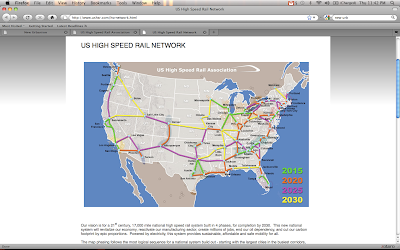High speed rails are not limited by weather problems like planes, but their carbon emissions are 1/6 that of an airlines. Spain plans to continue adding high-speed lines until 90% of its citizens are within 30 miles. The success of Spain's rails shows that, "If you build it (successfully), they will come." This concept can be seen in our own auto and air travel trends. When comparing the U.S. Department of Transportation's analysis of Federal Investment vs. Intercity Travel Trends, it is noted that higher investment led to more usage by Americans. Such investment needs to be applied to high-speed trains. If today, our government invests $60 billion per year into automobile infrastructure, what harm could there be in a one-time investment of the same magnitude into rail line development?

Unfortunately the plans were recently put on hold "until further notice" because too many state grants were filled, pushing the budget much higher than expected. Secondly, investigations of fraudulent grants are taking place.
---
SOURCES
---
OAG.com
wired.com
railnews.co.uk
U.S. High Speed Rail.pdf


No comments:
Post a Comment